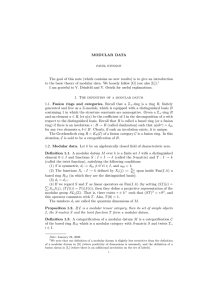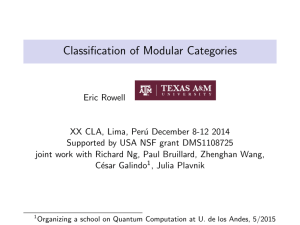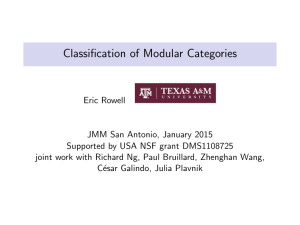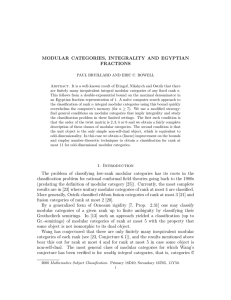Topological Quantum Computation: Rank-Finiteness and Classification of Modular Categories
advertisement
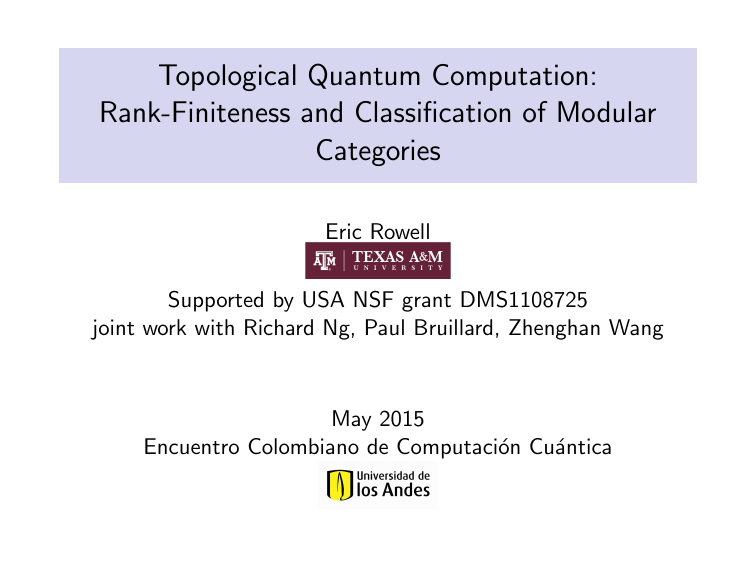
Topological Quantum Computation:
Rank-Finiteness and Classification of Modular
Categories
Eric Rowell
Supported by USA NSF grant DMS1108725
joint work with Richard Ng, Paul Bruillard, Zhenghan Wang
May 2015
Encuentro Colombiano de Computación Cuántica
Topological Quantum Field Theory with boundary
Set Up
A (unitary) (2+1)-TQFT assigns to each “nice” surface with
labelled boundary (M, `) a Hilbert space: H(M, `), satisfying some
rules.
Label i ∈ L, finite set with involutionˆ. Usually, L =SIMPLE
OBJECTS in a modular category C.
Boundary=circles: i · · · j
Axioms
I
empty: H(∅) = C
I
disk: H(D 2 ; a) = Cδa0 annulus: H(A; a, b) = Cδa,b̂
I
pants (3-punctured sphere): P := D 2 \ {z1 , z2 }
c
c are fusion rules for C.
H(P; a, b, c) = CNa,b e.g. Na,b
Two axioms
Axioms
I
Disjoint Union
`
H((M1 , `1 ) (M2 , `2 )) = H(M1 , `1 ) ⊗ H(M2 , `2 )
I
Gluing If Mg is obtained fromL
gluing two boundary circles of
M together then H(Mg , `) = x∈L H(M, (`, x, x̂))
Exercise (1. TQFT)
Show that H(S 2 ) ∼
= C and H(T 2 ) ∼
= C|L| :
T2
Example: Fibonacci Theory
I
L = {0, 1}
I
C
pants: H(P; a, b, c) = C
0
I
I
a=b=c
a + b + c ∈ 2Z
else
Define: Vki := H(D 2 \ {zi }ki=1 ; i, 1, . . . , 1)
(
Fib(n − 2) i = 0
dim Vni =
Fib(n − 1) i = 1
A (2 + 1)TQFT has a finite label set L:
Question
Fix r ∈ Z. Are there finitely many inequivalent (2 + 1)TQFTs with
|L| = r ?
I
Physically: Are there finitely many r -particle systems of
topological phases of matter?
I
Algebraically: Are there finitely many rank= r modular
category?
Definition
A modular category C (over C) is
monoidal: (⊗, 1), L
semisimple: X ∼
= i mi Xi ,
linear: Hom(X , Y ) ∈ VecC ,
rigid: X ∗ ⊗ X 7→ 1 7→ X ⊗ X ∗ ,
finite rank: Irr (C) = {1 = X0 , . . . , Xr −1 },
spherical: uX θX : X ∼
= X ∗∗ , dim(X ) ∈ R,
braided: cX ,Y : X ⊗ Y ∼
= Y ⊗ X,
modular: Det(TrC (cXi ,Xj∗ cXj∗ ,Xi )) 6= 0.
Remark
I
Tij = δij θi encodes θ and ord(T ) < ∞.
I
Sij := TrC (cij ∗ cj ∗ i ) the S-matrix.
Not as abstract as you think:
Let S, T be the S-matrix and
P T -matrix from a modular category
of rank r and define p± := j dj2 θj±1 . Then we have:
t
1. S = S t , SS = D 2 Id, T diagonal, ord(T ) = N < ∞
2N
2. (ST )3 = p+ S 2 , p+ p− = D 2 , pp−+
=1
P S S S
3. Nijk := a iaD 2jada ka ∈ N
P
4. θi θj Sij = a Nik∗ j dk θk where Nii0∗ uniquely defines i ∗ .
n
P
∈ Z[ζN ] satisfies:
5. νn (k) := D12 i,j Nijk di dj θθji
ν2 (k) ∈ {0, ±1}
6. Q(S) ⊂ Q(T ), AutQ Q(S) ⊂ Sr , AutQ(S) Q(T ) ∼
= (Z2 )k .
7. Prime (ideal) divisors of hD 2 i and hNi coincide in Z[ζN ].
Rank-Finiteness
Theorem (Bruillard,Ng,R,Wang 2013)
There are finitely many modular categories of a given rank r .
Theorem (E. Landau 1903)
There are finitely many finite groups G with exactly r irreducible
representations (over C).
Exercise (1. Group Theory)
P
Given that the Diophantine equation 1 = ri=1 x1i has finitely
many solutions for fixed r and xi ∈ Z+ , prove Landau’s Theorem.
Notation/Basic Facts
For a modular category we have:
I
Fusion rules: Nijk := dim Hom(Xi ⊗ Xj , Xk ) These satisfy
∗
∗
Nijk = Njik = Nikj ∗ = Nik∗ j ∗ .
I
S-matrix: Sij := TrC (cij ∗ cj ∗ i ) S = S T
P −1 2
Dimension function: D 2 := ri=0
di Here di = S0i .
I
T -matrix: Tij = δij θi has finite order.
I
Fusion matrices (Ni )k,j = Nijk simultaneously diagonalized by
S.
I
SS † = D 2 Ir .
I
Definition
r ∈ R is an algebraic integer if there is a monic polynomial
f ∈ Z[x] such that f (r ) = 0.
Lemma (Etingof Gelaki)
The numbers D 2 /di2 are algebraic integers.
Exercise (2. Number Theory)
Prove this. Hint: the eigenvalues of Ni are
Sij
dj
for 0 ≤ j ≤ r − 1,
and the square length of each column of S is D 2 .
P −1 2
Goal: prove D 2 = ri=0
di has finitely many solutions (for di
simple dimensions in a modular category).
Cauchy Theorem
Theorem (Lagrange/Cauchy)
Let G be a finite group, and N := exp(G ) ∈ N minimal such that
g N = e for all g ∈ G . Then |G | and N have the same set of prime
divisors (in Z).
Define ON := Z[e 2πi/N ] be the integers in Q[e 2πi/N ].
Proposition (BNRW)
Let C be a modular category, with ord(T ) = N. Then hD 2 i and
hNi have the same prime divisors in ON .
Example
√
C = Fib: D 2 = 5+2 5 and N = 5. Set ζ5 = e 2πi/5 .
hD 2 i = h1 − ζ5 i2 and h5i = h1 − ζ5 i4 . (Why is h1 − ζ5 i a prime
ideal?)
Lemma
Fix r . There exists a constant M(r ) ∈ N such that for any modular
category with rank r and ord(T ) = N we have
N | M(r )
Exercise (3. Group Theory)
Prove this lemma given:
1. G = Gal(Q(Sij )/Q) is an abelian subgroup of Sr
2. G ∼
= Gal(Q(e 2πi/N ))/(Z/2Z)k ∼
= (Z/NZ)∗ /(Z/2Z)k .
Remark
Here Q(Sij ) is the extension of Q generated by all entries Sij of the
S-matrix.
Example
Suppose r = 2. Then Gal(Q(Sij )) ∼
= Z/2Z or 1. Which N have
(Z/NZ)∗ /(Z/2Z)k ∼
Z/2Z
or
1?
=
Only divisors of: 120 = 8 · 3 · 5 and 48 = 16 · 3. So M(2) = 240 is
minimal.
Exercise (4. Number Theory)
What is the minimal M(3)?
Analytic Number Theory
Let K be a number field and S ⊂ Spec OK be a finite set of prime
ideals. The set of S-units is:
Y
×
OK,S
:= {x ∈ K : hxi =
pαp }
p∈S
where αp ∈ Z.
Example (p prime)
Set ζp = e 2πi/p , K = Q(ζp ) and p = h1 − ζp i. Notice hpi = pp−1 .
×
Let S = {p}, and x = ba ∈ K where a, b ∈ OK . We have x ∈ OK,S
iff p ⊃ hai and p ⊃ hbi.
Theorem (Evertse 1984)
Fix r ∈ N. There are finitely many solutions to
×
0 = 1 + x0 + · · · + xr −1 with xi ∈ OK,S
such that no sub-sum of
1 + x0 + · · · + xr −1 vanishes.
We now apply it to our situation:
1. Set N = M(r ) and
Sr := {p|ON ⊃ p ⊃ hNi}.
Notice |Sr | < ∞.
2. Dimension equation: 0 = 1 + d12 + · · · + dr2−1 − D 2 has
d12 , . . . , dr2−1 , −D 2 all Sr -units.
3. No subsum vanishes (since all are positive and < D 2 ).
4. Evertse implies: † finitely many possible solutions
(d12 , . . . , dr2−1 , −D 2 )!
5. In particular, di and D 2 bounded from above and below.
Set FPdim(Xi ) := max Spec(Ni ) and FPdim(C) :=
P
j
FPdim(Xi )2 .
Lemma
Let C be a modular category of rank r .
(a) There exists a j such that FPdim(C) = D 2 /(dj )2 .
(b) Let C be a modular category of rank r . Then FPdim(C) is
bounded.
Exercise (5. Linear Algebra)
Prove this lemma, by considering the columns of S-matrix for (a),
then apply bounds for (b).
Lemma
maxk,j {Nijk } ≤ FPdim(Xi ) < FPdim(C).
Exercise (6. Linear Algebra)
Prove this, using the 2-norm: ||A||22 := ρ(A† A) where ρ is the
spectral radius.
We now appeal to:
Theorem (Ocneanu Rigidity)
There are finitely many braided fusion categories with fixed fusion
rules {Nijk }.
Theorem
Rank-finiteness holds for modular categories.
Proof.
1. We have shown, that if C is a rank r modular category then
FPdim(C) is bounded.
2. Since Nijk < FPdim(C), there are finitely many possible fusion
rules for rank r modular categories categories.
3. Since ord(T ) is bounded, there are finitely many compatible
spherical structures for the braided fusion category underlying
C.
Problem
Classify all rank r modular categories. (perhaps with some extra
conditions)
Done for r ≤ 5 (various papers: Hong, Ng, Bruillard, Wang, Stong,
R): Up to fusion rules they are
1. SU(2)k for k = 2, 3, 4, PSU(2)k for k = 3, 5, 7, 9
2. SU(N)1 for N = 1, 2, 3, 4, 5
3. PSU(3)4
4. SO(4)1
Rank 2
Let’s classify rank 2 modular categories:
1 x
†
2
1. By SS = D I we get S =
with x ∈ R
x −1
1 x hence x = 1:
2. If x ∈ Z, dimensions give: x 2 = 1 + N11
SU(2)1 . So assume x 6∈ Z
1 xθ .
3. Balancing equation: S11 θ12 = −θ12 = 1 + N11
1
x 6∈ Z ⇒ θ1 6∈ R, so [Q(θ1 ) : Q] = 4. Thus
ord(T ) ∈ {5, 8, 10, 12}.
4. Twist equation: (ST )3 = p+ S 2 implies
(1 + θ1 x 2 )x = θ1 (1 − xθ1 ) so x 2 = 1 − 2<(θ1 ) > 0.
Therefore, N ≤ 5.
1 = 1, x 2 − x − 1 = 0: PSU(2) .
5. N = 5 gives N11
3
Thank you!

